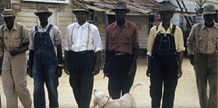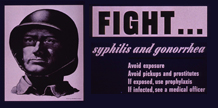Learning from the Past
Throughout history, racial and ethnic minorities and other vulnerable groups of people, such as children hospitalized for mental health problems, prisoners, women, and the poor, were sometimes mistreated or abused in health and medical research.
The legacy of research abuse casts a long shadow and today, lives on through books and movies about these cases. It is now part of the collective memory for many racial and ethnic minority groups and forms the basis of their legitimate distrust of researchers and the medical care system. It is important to first learn from the past in order to make things better in the future.
Listen to Jackie Scott, Adrienne Maddux, and Susan Reverby discuss the importance of acknowledging the past as researchers when working with racial and ethnic minority communities.
U.S. Public Health Service Study of Untreated Syphilis at Tuskegee (1932–1972)
"Tuskegee" might be the most well known example of research abuse. The study began in 1932, as a way to learn more about the nature of the venereal disease syphilis. The participants were 601 African American men from Macon County, Alabama. 399 of the men had syphilis and 201 did not. The researchers, who were part of the U.S. Public Health Service, were not honest about the nature of the study calling it instead a study of “bad blood” which locally could have referred to several ailments. They also withheld treatment even after penicillin became available.
The study ended in 1972 when an article in the Washington Star led to public outrage. At the end of the study, only 74 of the test subjects were alive. Of the original 399 men, 28 had died of syphilis, 100 were dead of related complications, 40 of their wives had been infected, and 19 of their children were born with congenital syphilis. In December of 1974, the government paid $10 million in an out-of-court settlement and provided free health care to the men and their families. In the aftermath, congressional hearings led to the Belmont Report.
In 1997, there was an apology from President Clinton on behalf of the United States government for the U.S. Public Health Service Syphilis study at Tuskegee Institute in which Clinton said, "We can stop turning our heads away. We can look at you in the eyes and finally say, on behalf of the American people, what the United States government did was shameful and I am sorry." Survivors were present.

The Tuskegee Syphilis Study

Guatemala Syphilis Study

Jewish Chronic Disease Study
Sexually Transmitted Disease Research in Guatemala (1946 – 1948)
In this study, U.S. Public Health Service researchers used prostitutes to infect prison inmates, insane asylum patients, and Guatemalan soldiers with syphilis, gonorrhea, and other sexually transmitted infections. Later, researchers tried infecting people with "direct inoculations." As a result, hundreds of people were infected as part of the study, including orphan children.
The purpose of the study was to test the effectiveness of penicillin as treatment for sexually transmitted infections. The team was led by Dr. John Cutler, who later participated in the U.S. Public Health Service Syphilis Study at Tuskegee. Cutler chose to do the study in Guatemala because he would not have been permitted to do it in the United States.
This incident, like the study at Tuskegee, resulted in a presidential apology. On October 1, 2010, President Barack Obama apologized to President Alvaro Colom in the aftermath of news reports about the Guatemalan Syphilis Study. In 2011, the Presidential Commission for the Study of Bioethical Issues produced the report, "Ethically Impossible": STD Research in Guatemala from 1946 to 1948.
The Jewish Chronic Disease Hospital Study (1960)
In 1963, Dr. Chester Southam of the Sloan-Kettering Institute for Cancer Research and Dr. Emanuel Mandel, research director at the Jewish Chronic Disease Hospital in New York injected live cancer cells into 22 patients at the hospital without first informing the patients about the research and obtaining their consent. The patients who received the injections were never told that the injections contained cancer cells or that the injections were unrelated to their normal therapeutic care. And, in fact, the word “cancer” was deliberately not used, and patients instead were told that they were receiving "some cells."
In 1964, Southam and Mandel’s conduct was questioned in a hearing before the Board of Regents of the University of the State of New York. The doctors were found guilty of fraud and deceit and unprofessional behavior for their failure to obtain valid informed consent from the patients, and the regents voted to revoke their medical licenses. In the end, however, the doctors were simply put on probation, and Southam went on to publish the results of his study in the Annals of the New York Academy of Sciences.
Media exposure of the case, however, helped fuel the emerging debate about the importance of informed consent, which was not uniformly required by researchers at the time. In response to the case, Sloan-Kettering began requiring written consent. Southam disagreed with their decision, stating that "The reason we did not tell them was for their own sake...To inform them more explicitly about the experiment, [their] defense would have to be broken down. To what purpose? I told them they would be getting some cells, and I described what would happen, but—since I believed there was no risk to them under the circumstances—to tell them the nature of the thing injected seemed irrelevant."
Today, informed consent for medical procedures is legally required in all 50 states, and informed consent has become the foundation for U.S. research studies.
What Was Learned
In each of these examples, the pursuit of an important scientific question was accomplished at the expense of people who were vulnerable because of their race, poverty, disease, or other factors. These individuals had no opportunity to make an informed decision about participating in the research study or were deceived about the study. In the aftermath of such research abuses, federal laws were put in place to protect people who participate in research, including strict guidelines for informed consent. You can learn about these protections in the next section, "Protections Today."
Additional Resources
-
Acknowledging the Past
-
CDC Features: U.S. Public Health Service Syphilis Study at Tuskegee
-
CDC Synopsis and Timeline of US Public Health Syphilis Study at Tuskegee
-
Ethically Impossible
-
Ethically Impossible: Study Guide
-
The Ethics of Consent: Theory and Practice
-
The Oxford Textbook of Clinical Research Ethics
Important Question
How does this history of research abuse in the past shape your willingness to participate in research today?



